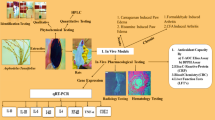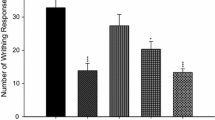Abstract
The leaves of traditionally used herbal plant Tridax procumbens L. contain lots of phytochemicals having potency to reduce inflammation. In this study, the ethanol extract of the leaves of Tridax procumbens L. was analysed for the phytochemicals by GC–MS. The anti-inflammatory activity was then studied with the extract of 10, 50, and 100 mg/kg b.wt in carrageenan-induced mice model by measuring the inflammatory oedema and by analysing the histopathology. The mRNA expression levels of TNF-α and COX2 genes were studied in the inflammatory site to explore the molecular action by reverse transcription PCR and qPCR analyses. A significant (P ≤ 0.01) reduction in mice paw inflammation and a recovered histology were observed in treated groups when compared to control group in 24 h. The RT-PCR results showed a significant (P ≤ 0.01) decrease in the expression levels of TNF-α and COX2 in terms of band density in treated mice compared to control group. The qPCR RQ values also were decreased in treated groups with respect to increasing doses (RQ values of 18.985 ± 0.230, 12.140 ± 1.121, 6.718 ± 0.807 for TNF-α and 15.583 ± 1.043, 7.725 ± 1.013, 5.075 ± 0.615 for COX2, respectively for the three doses) in comparison with the control group (TNF-α 27.107 ± 2.254, COX2 20.626 ± 1.477). Tridax procumbens L. can be, thus, used for the development of a safe, natural, anti-inflammatory drug as it showed a strong inhibitory action on inflammation by acting at molecular level.





Similar content being viewed by others
References
Bjarnason I, Hayllar J, MacPherson AJ, Russell AS (1993) Side effects of nonsteroidal anti-inflammatory drugs on the small and large intestine in humans. Gastroenterology 104(6):1832–1847
Bradley JR (2008) TNF-α mediated inflammatory disease. J Pathol 214:149–160
Choa J, Lu TC, Liao JW, Huang TH, Lee MS, Cheng HY, Ho LK, Kuo CL, Peng WH (2009) Analgesic and anti-inflammatory activities of ethanol root extract of Mahonia oiwakensis in mice. J Ethnopharmacol 125:297–303
Cowan MM (1999) Plant products as anti-microbial agents. Clin Microbiol Rev 12:564–582
Eslami M, Sofiabadi M, Haghighian HK, Jamshidi S (2019) Investigating the effect of luteolin on interleukin-1 and tumor necrosis factor in inflammation induced by lipopolysaccharide in male rats. Jundishapur J Nat Pharm Prod 14(3):e58271
Feldmann M, Maini RN (2001) Anti-TNF alpha therapy of rheumatoid arthritis: what have we learned? Annu Rev Immunol 19:163–196
Gad SS (2018) Effect of ginger as anti-inflammatory agent on serum nitric oxide, tumor necrotic factor α (TNF-α) and interleukin 4 (IL-4) in albino rats with carrageenan induced paw edema. Virol Immunol J 2:1–15
Gamboa-Leon R, Vera-Ku M, Peraza-Sanchez SR, Ku-Chulim C, Horta-Baas A, Rosado-Vallado M (2014) Antileishmanial activity of a mixture of Tridax procumbens and Allium sativum in mice. Parasite 21:15
Jachak SM, Gautam R, Selvam C, Madhan H, Srivastava A, Khan T (2011) Anti-inflammatory, cyclooxygenase inhibitory and antioxidant activities of standardized extracts of Tridax procumbens L. Fitoterapia 82:173–177
Lin L, Sun Y, Wang D, Zheng S, Zhang J, Zheng C (2016) Celastrol ameliorates ulcerative colitis-related colorectal cancer in mice via suppressing inflammatory responses and epithelial–mesenchymal transition. Front Pharmacol 6:320
Livak KJ, Schmittgen TD (2001) Analysis of relative gene expression data using real-time quantitative pcr and the 2−△△CT method. Methods 25:402–408
Manjamalai A, Varghese SS, Haridas A, BerlinGrace VM (2012a) Antifungal, anti-inflammatory and GC–MS analysis for bioactive molecules of Tridax procumbens L. leaf. Asian J Pharm Clin Res 5:139–145
Manjamalai A, Varghese SS, Haridas A, BerlinGrace VM (2012b) Essential oil of Tridax procumbens L. induces apoptosis and suppresses angiogenesis and lung metastasis of the B16F-10 cell line in C57BL/6 mice. Asian Pac J Cancer Prev 13(11):5887–5895
Meric JB, Rottey S, Olaussen K, Soria JC, Khayat D, Rixe O, Spano JP (2006) Cyclooxygenase-2 as a target for anticancer drug development. Crit Rev Oncol Hematol 59(1):51–64
Morikawa K, Nonaka M, Narahara M, Torii I (2003) Inhibitory effect of quercetin on carrageenan-induced inflammation in rats. Life Sci 74(4):709–721
Nakamura A, Fujiwara S, Matsumoto I, Abe K (2009) Stress repression in restrained rats by (R)-(−)-linalool inhalation and gene expression profiling of their whole blood cells. J Agric Food Chem 57(12):5480–5485
Nantel F, Denis D, Gordon R, Northey A, Cirino M, Metters KM, Chan CC (1999) Distribution and regulation of cyclooxygenase-2 in carrageenan-induced inflammation. Br J Pharmacol 128(4):853–859
Nia R, Paper DH, Essien EE, Oladimeji OH, Iyadi KC, Franz G (2003) Investigation into in-vitro radical scavenging and in-vivo anti-inflammatory potential of Tridax procumbens. Niger J Physiol Sci 18(1–2):39–40
Noshahr ZS, Shahraki MR, Ahmadvand H, Nourabadi D, Nakhaei A (2015) Protective effects of Withania somnifera root on inflammatory markers and insulin resistance in fructose-fed rats. Rep Biochem Mol Biol 3:62–67
Osadebe PO, Okoye FBC (2003) Anti-inflammatory effects of crude methanolic extract and fractions of Alchornea cordifolia leaves. J Ethnopharmacol 89:19–24
Pathan A, Alshahrani A, Al-Marshad F (2015) Protective effect of Tridax procumbens Linn. potential in ulcerative colitis by using myeloperoxidase activity in AlbinoRats. Invent Rapid Ethnopharmacol 2015:1–5
Prabhu V, Nalini G, Chidambaranathan N, Sudarshan Kisan S (2011) Evaluation of anti-inflammatory and analgesic activity of Tridax procumbens Linn. against formalin, acetic acid and CFA induced pain models. Int J Pharm Pharm Sci 3(2):126–130
Restivo A, Brard L, Granai CO, Swamy N (2005) Antiproliferative effect of mimosine in ovarian cancer. J Clin Oncol 23:3200
Sawant RS, Godghate AG (2013) Preliminary phytochemical analysis of leaves of Tridax procumbens Linn. Int J Sci Environ 2(3):388–394
Seibert K, Masferrer JL (1994) Role of inducible cyclooxygenase (COX2) in inflammation. Receptor 4(1):17–23
Shri JNM (2003) Ginger: it’s role in xenobiotic metabolism. ICMR Bull 33(6):57–63
Smith TJ (2000) Squalene: potential chemopreventive agent. Expert Opin Investig Drugs 9(8):1841–1848
Steinmeyer J (2000) Pharmacological basis for the therapy of pain and inflammation with nonsteroidal anti-inflammatory drugs. Arthritis Res 2(5):379–385
Stepp JR (2004) The role of weeds as sources of pharmaceuticals. J Ethnopharmacol 92:163–166
Suluvoy JK, Grace VMB (2017) Phytochemical profile and free radical nitric oxide (NO) scavenging activity of Averrhoa bilimbi L. fruit extract. 3 Biotech 7(1):85
Suseela L, Sarsvathy A, Brindha P (2002) Pharmacognostic studies on Tridax procumbens L. (Asteraceae). J Phytol Res 15(2):141–147
Takao K, Miyakawa T (2014) Genomic responses in mouse models greatly mimic human inflammatory diseases. Proc Natl Acad Sci USA 112(4):1167–1172
Udupa AL, Kulkarni DR, Udupa SL (1995) Effect of Tridax procumbens extraction in wound healing. Int J Pharmacogn 33(1):37–40
Williams DA, Lernke TL (2002) Non-steroidal anti inflammatory drugs, Foyes principles of medicinal chemistry, 5th edn. Lippincott Williams, Philadelphia, pp 751–793
Yu Y, Shen Q, Lai Y, Park SY, Ou X, Lin D, Jin M, Zhang W (2018) Anti-inflammatory effects of curcumin in microglial cells. Front Pharmacol 9:386
Zhang X, Dwivedi C (2010) Skin cancer chemoprevention by α-santalol. Front Biosci 3:777–787
Acknowledgement
The authors would like to thank the Department of Biotechnology, Karunya Institute of Technology and Sciences, Coimbatore, for funding this work in the form of seed money under the Short Term Research Grant (STRG). We also acknowledge the DST and DBT for partially supporting with chemicals required for gene expression studies.
Funding
This study was funded by Karunya Short Term Research Grant (REG/IQ/O/4264) and partially facilitated by Department of Science and Technology, SERB (SB/YS/LS-252/2013), and Department of Biotechnology, Government of India (DT/PR 14632/NNT/28/824/2015) funded projects.
Author information
Authors and Affiliations
Corresponding author
Ethics declarations
Conflict of interest
All the authors declare that they have no conflict of interest.
Additional information
Publisher's Note
Springer Nature remains neutral with regard to jurisdictional claims in published maps and institutional affiliations.
Rights and permissions
About this article
Cite this article
Berlin Grace, V.M., Viswanathan, S., David Wilson, D. et al. Significant action of Tridax procumbens L. leaf extract on reducing the TNF-α and COX-2 gene expressions in induced inflammation site in Swiss albino mice. Inflammopharmacol 28, 929–938 (2020). https://doi.org/10.1007/s10787-019-00634-0
Received:
Accepted:
Published:
Issue Date:
DOI: https://doi.org/10.1007/s10787-019-00634-0




